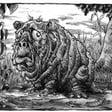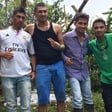Become a Creator today!Start creating today - Share your story with the world!
Start for free
00:00:00
00:00:01

Darkcast Diversion: 100 Seconds to Midnight
We LOVE our Darkcast Network shows, such as Cause of Death: !00 Seconds to Midnight! This show reminds us when and why to really be wary of humanity's collapse! Are we really going down with the next big Volcano eruption? etc.
It's so fascinating my friends, so sit back and see if bats are going to kill us or not. Or something else!
And we shall return next eek for your regular scheduled programming! so Keep it Cryptic!
Recommended
Transcript
Introduction and Importance of Bats
00:00:11
Speaker
Hello and welcome to Cause of Death 100 Seconds to Midnight. I'm your host, Jackie Maranti.
00:00:20
Speaker
Today we're talking about some of my favorite animals. I love bats. They're probably the most amazing creatures on the planet. Bats are the base of several ecosystems and without them, those ecosystems would fail.
00:00:33
Speaker
And without those ecosystems, several food sources would also fail.
Bats' Unique Abilities and Diversity
00:00:39
Speaker
But bats also carry some of the most deadly diseases known to mankind. SARS, MERS, coronavirus, Ebola, they all have their natural reservoirs in bats.
00:00:52
Speaker
People fear bats, maybe because they carry disease, maybe because they have visions of Dracula in their heads, maybe because they don't understand how invaluable they are.
00:01:04
Speaker
Bats have become targets of the people who consider them pests. Now several species are endangered, and that could be far worse for the ecosystems that they are a vital part of.
00:01:17
Speaker
It's 90 seconds to midnight, and a vital part of the chain of wildlife is coming under attack by humans who don't understand that bats are the intermediary between human life and death, in more ways than one.
00:01:33
Speaker
I thought it would be cool to take a look at the dichotomy of the bat. We would die without them, but they could kill us off just by existing. Bats are mammals of the order Chiroptera, meaning handwing.
00:01:48
Speaker
They are the only mammals capable of sustained flight. They have four limbs that are adapted as wings, and their digits are covered in a thin membrane called a pedagium.
Echolocation and Roosting Behaviors
00:02:00
Speaker
Bats are more agile in flight than most birds. That flexible membrane and the movable joints of the forefingers and thumb allow them to change direction very quickly and catch mosquitoes and other insects in midair.
00:02:15
Speaker
If you've never seen bats fly, it is a sight to behold. They are amazing to watch.
00:02:24
Speaker
Bats roost upside down. There are several theories on this, but the most widely accepted theory is that they do this because they have to fall into flight.
00:02:36
Speaker
In order to get enough momentum to go up, they have to let gravity take control first. There are 1,300 species of bats living in almost every country in the world.
00:02:49
Speaker
Some are no bigger than a child's palm. Others have six-foot wingspans. There are two types of bats, microbats and megabats.
00:03:01
Speaker
Microbats eat insects that come out at night. Vampire bats are the only species of bat that survives on blood rather than insects. And they usually get this blood from cattle and horses, not humans.
00:03:17
Speaker
Microbats live in caves and hunt after dark. So to get around, they rely on echolocation to locate objects using sound waves. They make a high-pitched sound that travels until it hits an object, then bounces back to them.
00:03:33
Speaker
This tells them how far away something is and how big it is.
00:03:40
Speaker
Megabats live in the tropics, and they eat fruit, nectar, and pollen. These bats have larger eyes and a stronger sense of smell, but since they don't echolocate, they have smaller ears.
00:03:54
Speaker
These bats are usually larger than microbats.
00:03:59
Speaker
Bats haven't gotten a fair shake by humans historically. They've been associated with disease, vampires, and overall creepiness, and all sorts of negative things. But before I get into the negatives, I want to talk about the positive things that bats offer ecosystems.
00:04:17
Speaker
Bats live in a variety of places, forests, caves, attics. Their habitats are called roosts, and normally they live in colonies. It's rare to see a single bat in a roost.
00:04:32
Speaker
They have different roosting conditions for different times of year. Most bats don't build their roost. They use whatever's there. And most of the time, these roosts are close to water and very dark and quiet.
00:04:48
Speaker
As the weather warms, pregnant females will gather together in a warm, safe place. These are called maternity roosts. Many bats will use the same maternity roost every year to have their young.
00:05:01
Speaker
The gestation period for a bat is between six and nine weeks. Bats will usually give birth to a single pup every year. They're very good moms and keep their pups close.
00:05:14
Speaker
Bats are mammals, so they give birth to live young and suckle them until they're weaned at about four or five weeks old. And then they're old enough to fly. And they can forage on their own.
00:05:29
Speaker
Bats are very sensitive when they're pregnant and just after giving birth. If they're disturbed before the pups are weaned, they may abandon them. So it's better to stay away from their habitats during early summer.
Bats' Role in Ecosystems and Urban Adaptation
00:05:44
Speaker
Bats mate in the fall, but they don't become pregnant until spring. The females will store the sperm until after hibernation so that they have enough energy to make it through pregnancy.
00:05:57
Speaker
Most bats will hibernate during the winter months.
00:06:02
Speaker
During hibernation, the animal will experience a drop in body temperature, their metabolic rate slows, and they'll survive on the fat they've stored up over the summer.
00:06:15
Speaker
Also during hibernation, bats will choose a place that remains the same temperature no matter what the weather is outside. Caves make perfect hibernation roosts since the temperature doesn't fluctuate a whole lot.
00:06:30
Speaker
Not all bats hibernate, though. Several species migrate to warmer climates when the weather doesn't suit them. Several species will roost in trees. About three-quarters of the British bat populations are known to roost in trees.
00:06:47
Speaker
Trees not only provide shelter for the animals, but they also attract a diverse range of bugs to eat. Bats will also roost in abandoned buildings, or if there's an opening in an attic, they'll get in there and roost.
00:07:03
Speaker
They'll make homes and houses, bridges, barns, and occasionally public buildings. There was a very old building on the CSU campus that was a bat sanctuary.
00:07:15
Speaker
Not on purpose, mind you, but there were just enough gaps in the attic that the bats made a huge roost in there. For any of you CSU alumni listening, this is the Gibbons building.
00:07:29
Speaker
It used to be where students in need of food, shelter, tutoring, or scholarships would go. That was a long time ago, though, so I'm not sure where those services are on campus now.
00:07:42
Speaker
But if you were walking along the northeast side of campus at dusk, you could watch the bats come out of the building when they went to forage at night. And it was pretty cool.
00:07:54
Speaker
Bats are known to live in urban areas. And if you know what you're looking for, they can be seen foraging all over even the biggest cities. From Denver, Colorado to Austin, Texas to Baltimore, Maryland and Los Angeles, the largest cities in the country are home to millions of bats.
00:08:15
Speaker
They've adapted to city life pretty well. And city bats are probably some of the best fed bats. There are plenty of bugs to eat out there. Bats live close to where they can forage for food, and they usually live near a water source.
00:08:31
Speaker
Their foraging grounds are as varied as the bats themselves. Microbats are carnivorous, mostly eating bugs, like mosquitoes. See how valuable they are already?
00:08:45
Speaker
On an average night, a single bat will eat its body weight in insects. These little flying acrobats save the agricultural industry over $3.7 billion dollars a year in pesticides.
00:08:59
Speaker
And this doesn't include the amount of insects that bats eat in forest habitats, which helps the lumber industry. Nor does it include the number of insects that bats eat in urban areas.
00:09:13
Speaker
Macrobats are important crop pollinators. These bats live by eating the nectar from plants. So as they move from plant to plant and flower to flower, they pollinate them.
00:09:25
Speaker
Without bats, we wouldn't have saguaro cactus or pipe cactus. There would be no bananas, no mangoes, no avocados, no nuts, figs, caco, or coffee.
00:09:38
Speaker
Nor would there be tequila. Bats pollinate agave.
00:09:46
Speaker
Think about it. Bats pollinate over 300 species of fruit. They spread seeds for various other plants. Some of the plants that bats pollinate are used for medicines.
00:09:58
Speaker
Yes, folks, many of our medicines are made from plants. They're not all engineered by magic. About 80 species of medicinal plants are pollinated by bats.
00:10:11
Speaker
And I don't know about you, but without coffee, chocolate, guacamole, and mangoes, I don't think I can survive.
00:10:19
Speaker
Bats have helped us use echolocation in radar systems. They've also helped us figure out navigational aids for the blind. And research on bats has helped us develop vaccines.
00:10:34
Speaker
That's how important bats are. We depend on them for all of that.
00:10:40
Speaker
That $3.7 billion dollars that helps the ag industry and bug control? That number just went to priceless. These animals are very much worth protecting, which means that we need to protect their habitats as well.
Threats Facing Bat Populations
00:10:57
Speaker
Noise and light pollution, pesticides, and wind turbines are some of the biggest hazards to bats. While some bats have adapted to streetlights and will catch as many bugs as hang out there, others have not.
00:11:12
Speaker
A study was done on the effects that light pollution has on the lesser horseshoe bat by Emma Stone, a PhD student at the University of Bristol in the UK.
00:11:24
Speaker
Dr. Stone is a researcher at the University School of Biological Sciences.
00:11:32
Speaker
Now, I'm not going to go through the entire setup of the study, or we'd be here all night, and I have other things that I need to talk about. But I do want to sum up the findings. When the lights were turned on in a known commuter path used by bats, 42% flew through the lights, 30% reversed direction and left before they got to the lights. 17% flew over the hedgerows that were fully illuminated.
00:12:03
Speaker
9% flew through the densest part of the hedgerows, and 2% flew in circles to avoid the lights. Dr. Stone's team also observed bats flying between the lights in darker areas, but then flying up and down repeatedly as if trapped by the lights.
00:12:26
Speaker
On nights where the lights were left off, the bats began their nightly forage at 29.9 minutes after sunset. But when the lights were turned on, they began their forage at 78.6 minutes after sunset.
00:12:42
Speaker
On the nights that the lights were on, the bats never got used to it. They didn't go back to their normal activity or timing. All right, so what does this actually mean for the bats?
00:12:57
Speaker
The results of this study suggest that light pollution may extend the routes that the bats will take to their normal hunting grounds. This increased time could increase the energy expended and put undue stress on the animals, and eventually this could impact their reproductive success.
00:13:18
Speaker
Other studies have found that when roosts are exposed to artificial lights, the bats will either delay leaving the roost or not leave at all. They may completely abandon that roost.
00:13:30
Speaker
And this also affects their feeding behavior away from the roost. Noise is probably the worst type of pollution for humans and animals, but noise invades our lives 24-7-3-65.
00:13:45
Speaker
Many species of bat use echolocation to find food and avoid objects and even find one another. Noise pollution threatens their survival.
00:13:57
Speaker
It makes them less active, and they often abandon roosts where noise pollution is high. This forces more and more bats to move to areas that are quieter, and we're running out of quiet areas.
00:14:13
Speaker
Several studies have been done on the ways that noise and radio waves affect bats, and most of them come to the same conclusion. Much like light pollution, noise can confuse them and put them under more duress than is necessary.
00:14:28
Speaker
Dr. Domnal Finch performed a two-year study that was funded by the Vincent Wildlife Trust on the effect of road noise on the horseshoe bat.
00:14:40
Speaker
His team recorded road noise from a busy highway and took the recordings into a natural bat habitat. They used both sonic and ultrasonic spectrums of traffic.
00:14:54
Speaker
They found that from 20 meters away from the noise, bat activity dropped approximately two-thirds. They also noticed that there was a reduction in feeding buzzes, meaning that the bats weren't feeding as well as they did before the noise.
00:15:12
Speaker
The sonic spectrum seemed to have the highest impact on bat activity. They didn't necessarily think that the noise was jamming their echolocation, but rather that bats were just trying to avoid the noise.
00:15:26
Speaker
At the end of the experiment, Dr. Finch's team surmised that road noise could potentially have a negative effect on habitat quality, landscape connectivity, and population viability.
00:15:39
Speaker
Any one of these things impacts the survival of the species.
00:15:46
Speaker
Pesticides also kill thousands of bats every year. We poison the best pesticide that we have. If a bat eats its body weight in bugs that have been sprayed with insecticides, they will also be poisoned.
00:16:01
Speaker
Put that on top of the fact that we're killing off their food source, and you can see how pesticide use can be a real problem for the entire order.
00:16:11
Speaker
I'm putting an honorable mention in here on the wind turbines. This form of clean energy is known to have negative impacts on several species, but particularly on any species that flies.
00:16:26
Speaker
Birds and bats get caught in the blades and die. It seems that every wind farm that I've ever had the chance to visit has been littered with the mangled bodies of flying creatures.
00:16:39
Speaker
I'm not ah entirely sure that the risks are worth the rewards when so many animals die.
00:16:47
Speaker
Bats don't have a lot of natural predators. Owls, hawks, and snakes will eat bats. But the thing that is decimating the entire order is white-nose syndrome.
00:17:00
Speaker
White-nose syndrome is a fungal infection that begins around the animal's face, then spreads to their body. Often this disease disrupts their hibernation and feeding patterns, essentially causing them to starve to death.
00:17:15
Speaker
Several hibernating bat species have been affected to the point of near extinction by white-nose syndrome.
Medical Insights from Bats
00:17:22
Speaker
People bring the fungus into the caves where the bats roost, and that's how they get it.
00:17:30
Speaker
I'm not going to say a lot about it now, but on the next cause of death, 100 Seconds to Midnight, you're going to hear everything about White Nose Syndrome.
00:17:42
Speaker
While we threaten bats just by being human, bats threaten us just by being bats. Bats are natural reservoirs for several diseases that are fatal to mankind.
00:17:54
Speaker
They carry rabies, Nipah virus, Ebola, SARS, MERS, Lysivirus, parasites, histoplasmosis, salmonellosis, ursinosis, and a host of other diseases that can be fatal to humans.
00:18:11
Speaker
These diseases can be transmitted by bites, scratches, mucous membrane exposure, or coming into contact with guano, especially by breathing in dried guano.
00:18:26
Speaker
So the moral of this story is don't pet the bats and stay away from their feces. Watch them fly, enjoy their hunts, but leave them alone.
00:18:37
Speaker
It's rare for a bat to bite a human. They're not aggressive animals and will usually just try to fly away. If you see a bat during the day or one that's acting erratically, don't touch it.
00:18:49
Speaker
Call Fish and Wildlife to come and take it.
00:18:53
Speaker
Okay, so if bats carry all these diseases, how do they survive? Why don't they get sick and die? This is what makes the bat a medical marvel.
00:19:06
Speaker
Bats have a gene structure that helps them evade disease. They can modulate their own immune systems to essentially neutralize almost anything that invades.
00:19:19
Speaker
Once the infection has been neutralized, they can turn off the impending inflammation before it can damage the host. Way back in the beginning of this podcast, I did a more than you ever wanted to know episode where I explained how the human immune system worked.
00:19:37
Speaker
I talked about how inflammation is one of the ways that the body fends off infection. One of our inflammatory responses is fever. Our bodies try to burn the infection out.
00:19:52
Speaker
But fever can also harm us. Many people die because their fever spikes too high. A prolonged fever of over 103 is considered critical.
00:20:03
Speaker
And unless that fever comes down quickly, our own immune response can do irreparable damage to our internal organs, the brain in particular.
00:20:15
Speaker
Bats can shut that immune response down as soon as the pathogen is neutralized by their immune system, so they won't spike a dangerously high fever. What's even more extraordinary is the immune system of a bat can evolve as quickly as the virus that's invading.
00:20:34
Speaker
This amazing mechanism is coded into their DNA. Researchers have been studying bat DNA for several years, and understanding their immune system has helped create therapies for humans against the diseases that they carry.
00:20:52
Speaker
Bats may also hold the secret to youthfulness. These critters can live for up to 40 years, and that makes them the longest-lived species of their size. Normally, the smaller the species, the shorter the lifespan.
00:21:07
Speaker
But bats have evolved to evade that niggling problem too.
00:21:13
Speaker
A study done by the BAT1K Consortium, a bat conservancy program, found that certain genes related to aging are altered in the bat species.
00:21:25
Speaker
As we age, we accumulate junk in our bodies, dead cells with nowhere to go. But bats have evolved to clean up the dead cells and dispose of them.
00:21:37
Speaker
They throw out the trash. This is a process called autophagy. They also maintain their telomeres. Telomeres are the caps on the ends of chromosomes.
00:21:51
Speaker
In humans, these telomeres will gradually come undone. This leads to aging, but can also lead to cancer in older people.
00:22:03
Speaker
Our bodies lose maintenance as we age. Our immune systems weaken. And we are at risk of increased inflammation. Our telomeres unravel. Humans are a mess the older we get.
00:22:18
Speaker
Bats, on the other hand, up their immune system game as they get older. Not only do they maintain their telomeres, but their immune system becomes stronger.
Conservation Efforts for Bats
00:22:29
Speaker
Their mitochondria won't wreak havoc on their bodies.
00:22:34
Speaker
Research is ongoing into the genetics that make the bat such a naturally healthy animal. But these phenomena could lead to cures for many diseases in humans, including cancer and rheumatoid arthritis.
00:22:49
Speaker
There are several ways that we can help bats survive. I've put a video in the show notes that gives step-by-step instructions on making a bat house for your yard. I've also got an article in there that tells you what kind of plants to put in your garden.
00:23:05
Speaker
The easiest way to help bats is to shut off the lights at night. If you have a yard light, don't leave it burning all night long. Only use it when you need to go outside. Keep the noise levels at your house down to a low roar.
00:23:21
Speaker
The less roar, the better. If you keep cats, keep them in at night. Don't let them roam near what could possibly be a bat habitat. Before doing any remedial work on an attic, check to make sure the bats haven't begun to roost there.
00:23:39
Speaker
Many of the articles listed in the show notes are written by conservancy agencies. They give some great advice on bats and how we can all do our part to save this magnificent order.
00:23:52
Speaker
It's 90 seconds to midnight, and the world's greatest asset is being destroyed by a fungal disease that is largely incurable, by the encroachment of wild lands, and by technology.
00:24:07
Speaker
Largely, they're being destroyed by man. This order helps mankind in so many ways, from pest control to pollination to cures for diseases that plague us.
00:24:20
Speaker
If we destroy the bat, do we destroy humankind?
00:24:26
Speaker
Please check the show notes for ways that you can support Cause of Death 100 Seconds to Midnight. And visit my amazing sponsor for this month, True Leaf Market. The quality of seeds that I received is remarkable.
00:24:41
Speaker
Some of my little plants are potted already. And they have cover plants that will attract bats. Go check them out.
Episode Milestone and Dinosaur Exploration
00:24:52
Speaker
Thank you all for listening, and I'll see you in two weeks when I give you the skinny on white nose syndrome.
00:24:58
Speaker
Until then, go build a bat house.
00:25:20
Speaker
I'm Edward October, creator host of OctoberPod, and we're both listening to Calls of Death on the Darkcast Network.
00:25:40
Speaker
Hello, and welcome to the 50th episode of Cause of Death 100 Seconds to Midnight. I'm your host, Jackie Morante.
00:25:51
Speaker
I'm so excited to have made it to 50 episodes. I figured that I would have given up by now. A lot goes into making this show, and sometimes it gets overwhelming.
00:26:01
Speaker
But here we are, the 50th episode. As promised, this is the crossover episode between Cause of Death and 100 Seconds to Midnight.
00:26:12
Speaker
I'm going to do a little bit of both shows. I thought it was fitting for the occasion. I'm using music from both shows too. The beginning will be the cause of death music and the 100 seconds to midnight music comes in a little later.
00:26:29
Speaker
This story addresses both sides of my shell. I'll begin by talking about a disease that has the potential to kill off an entire species and I'll end with the chaos of a species that's already extinct.
00:26:43
Speaker
Today I'm going to explore the death of Dolly, the disease-doomed dinosaur. Let's begin with the etiology and pathology of a pathogen, Aspergillus fumigatus.
00:26:57
Speaker
I'm going to focus more on the pathology than the etiology of this disease because the mechanisms are not well understood. I've read several papers on host invasion and genetics of this particular mold, but none of them agree.
00:27:12
Speaker
i would rather wait and give you information that I know to be true than have you emailing me because I'm contradicting myself at every turn.
00:27:21
Speaker
I am going to talk about the reproductive system of the mold, since we haven't explored that before. Viruses can't reproduce outside of a host, and bacteria needs a particular environment to reproduce.
00:27:34
Speaker
So, they both need hosts, but molds and other fungi don't. They can reproduce on their own. Let's start there, and then we'll move on to pathology.
00:27:48
Speaker
In order to understand mold reproduction, I need to define some things, and then talk about environmental conditions. Molds are multinucleated filamentous fungi that are made up of hyphae.
00:28:02
Speaker
These are branching tubular structures that range from 2 to 10 micrometers in diameter and are usually divided into cell-like units by cross walls called septa.
00:28:14
Speaker
The entire hypha, including the septa, is called mycelium. Now, I want you to imagine a tree. Many molds look like trees under a microscope.
00:28:27
Speaker
The bottom of the mold is called a vegetative mycelium. This is the part that grounds the mold to whatever it's growing on and also absorbs the nutrients from that thing.
00:28:39
Speaker
It functions like the roots of a tree.
00:28:44
Speaker
The aerial mycelium could be compared to branches. This is the part of the mold that produces asexual reproductive spores. Sort of like the branches of the tree form leaves or seeds that will contribute to the reproduction of that tree.
00:29:03
Speaker
The bark of the mold is called the cell wall, and it's composed mostly of chitin. The cell wall surrounds a cell that is eukaryotic, so it has a nucleus.
00:29:16
Speaker
Unicellular organisms, such as animals, plants, and fungi, are eukaryotic organisms. Molds reproduce primarily through asexual reproductive spores.
00:29:28
Speaker
These spores include conidiospores, sporangiospores, and arthrospores. These spores can be carried by air, water, animals, or other objects, and when they land in a nice, moist environment, they can germinate and produce new hyphae.
00:29:47
Speaker
Molds may also reproduce by sexual spores, such as ascospores and zygospores, but this doesn't happen often.
Mold Infections in Dinosaurs
00:29:56
Speaker
During sexual reproduction, two different mating types of hyphae form short-sighted branches.
00:30:03
Speaker
If the tips of these branches meet, they produce reproductive cells called gametes. The gametes will join together to form a zygote. The zygote will then form a wall around itself for protection.
00:30:17
Speaker
This wall is called zygospore. A few months later, the zygospore will germinate and the process will begin all over again. Sexual reproduction, again, is rare in molds.
00:30:31
Speaker
Most commonly, molds will reproduce asexually. A-fumigatus is no exception. This mold almost exclusively uses asexual reproduction to continue the line.
00:30:44
Speaker
The means by which molds reproduce along with their appearance are factors in the identification and classification of molds. We know from looking into viruses and bacteria that environment matters to them.
00:30:58
Speaker
Aspergillus species are very thermotolerant. They're able to withstand most weather conditions and survive well in decaying matter. Cold doesn't bother them, and as long as they have moisture, they can grow anywhere.
00:31:13
Speaker
This is why they can grow so well inside of a host A human male is made up of 60% water, so this mold feels very at home inside a human host.
00:31:26
Speaker
They also carry melanin. Melanin is a complex polymer that's derived from the amino acid tyrosine. Melanin gives pigment. If you've listened to the episode on my dog Sweet Pea, you know that her skin has no pigment.
00:31:44
Speaker
She doesn't produce melanin. This is why she's all white with pink skin and blue eyes. And it's also why she's deaf. In Aspergillus species, melanin aids survival in two important ways.
00:31:59
Speaker
The protective pigment helps the mold evade immune defenses of their hosts, and it also protects against UV rays. UV light is often used to kill bacteria on surfaces, and it doesn't work at all with mold.
00:32:15
Speaker
So, you ask, where is Aspergillus? Well, it's everywhere. Aspergillus fumigatus is a ubiquitous seprophytic mold that forms airborne spores called canidia.
00:32:31
Speaker
It exists in nature. There's no avoiding it. Anywhere there is rotting plant life, household dust, building materials, plants, food, or water, you have aspergillus.
00:32:43
Speaker
Check your cheese after you haven't seen it in a few weeks. Or those leftovers you brought home from the restaurant and never ate? Yeah, molds can survive anywhere.
00:32:55
Speaker
While most molds will survive eating dead or decaying organisms, there are parasitic molds that survive within or on living organisms. Aspergillus is one of those molds.
00:33:07
Speaker
It can survive in a living host.
00:33:12
Speaker
Less than 20 of the roughly 200 aspergillus species of mold cause human disease, though. A. fumigatus is the predominant isolate from nature. It's thought that the genetic diversity among fumigatus and the increased virulence patterns are the causes for this.
00:33:31
Speaker
This theory is also still under consideration since one hospital survey found that fumigatus represented less than 1% of airborne mold spores, yet it accounted for over 50% of patient isolates.
00:33:47
Speaker
By contrast, a Niger constituted more than half of the airborne isolates, but only 17% patient
00:33:58
Speaker
What this means is that fumigatus has a better chance of colonizing in the human respiratory tree than nigere, which is a lesser pathogen. The size of the mold, the rate of germination, and resistance to host killing mechanisms are likely factors in the success of fumigatus taking up residence in the pulmonary system of its host.
00:34:21
Speaker
Basically, molds are opportunistic pathogens that take advantage of any deficiencies in the immune system to cause disease. And once they've made themselves at home, they can spread to other parts of the body, wreaking havoc as they go.
00:34:37
Speaker
Okay, now, before I get a hundred emails from people saying that they're sure they're infected with Aspergillus fumigatus, Eric, let's back up a minute.
00:34:50
Speaker
People inhale hundreds of spores of the canidia on the daily. Those with healthy immune systems clear the spores through the pulmonary immune system. It's when the immune system proves to be too strong or too weak that disease can occur.
00:35:08
Speaker
Therefore, those who are immunocompromised are at higher risk for morbidity and mortality from aspergillus. those who have experienced organ transplantation, take any immunosuppressive or myeloablative therapy for autoimmune or neoplastic disease, or those who have HIV or AIDS are at the highest risk for infection.
00:35:32
Speaker
Morbidity and mortality are far greater among these populations than any other. This is the most common invasive mold infection for these patients, and the mortality rate among these populations is upwards of 50%.
00:35:48
Speaker
Sensitivity to aspergillus has been associated with asthma, but there is no strong proof that aspergillus causes asthma. Studies concerning the relationship between aspergillus and asthma are ongoing.
00:36:03
Speaker
Aspergillus is a lower respiratory infection. Most of the diseases that we've talked about so far are upper respiratory infections. Acute invasive pulmonary aspergillosis usually causes coughing with hemoptosis, pleuric chest pain, and shortness of breath.
00:36:22
Speaker
This form may lead to rapidly progressive and ultimately fatal respiratory failure if left untreated. Chronic pulmonary aspergillosis may manifest with mild indolent symptoms despite significant disease.
00:36:38
Speaker
Extrapulmonary invasive aspergillosis occurs in severely immunocompromised patients. It begins with skin lesions, sinusitis, or pneumonia, and may involve the liver, kidneys, brain, and other tissues via hematogenous dissemination and is often rapidly fatal.
00:37:00
Speaker
Aspergillosis in the sinuses can form an aspergilloma or cause allergic fungal sinusitis or a chronic slowly invasive granulomatous inflammation with fever, rhinitis, and headache.
00:37:15
Speaker
Patients may have necrosine cutaneous lesions overlying the nose or sinuses, palatal or gingival ulcerations, signs of cavernous sinus thrombosis, or pulmonary or disseminated lesions.
00:37:32
Speaker
Aspergillomas are usually asymptomatic, but may cause mild cough and occasionally hemoptysis. Treatment normally includes antifungals such as voroconazole, amfotricin B, caspofungin, or intraconazole.
00:37:51
Speaker
If fungus balls form, yes, I said fungus balls form, they may have to be removed by surgical resection.
00:38:03
Speaker
What is a fungus ball, you ask? A fungus ball or aspergilloma is a growth of tangled masses of hyphae within fibrin exudate.
00:38:15
Speaker
and a few inflammatory cells thrown in for good measure, all wrapped up in a fibrous tissue. Invasive infections usually require aggressive treatment with voriconazole or isovuconazole.
00:38:30
Speaker
There are other antifungals that can be used, but they are more toxic, and they have quite a few more side effects.
00:38:40
Speaker
Diagnosis isn't real comfy. Bronchio alveolar lavage and tissue samples are used for PCR testing.
Dinosaur Diseases and Modern Implications
00:38:48
Speaker
Sometimes a CT scan is helpful, but most of the time it's sputum and it's lavage.
00:38:55
Speaker
And it's totally uncomfortable.
00:39:10
Speaker
It's 100 seconds to midnight, and a story has been unfolding over the last couple of years about a dinosaur. Scientists call her, him, it, Dolly.
00:39:22
Speaker
Dolly may hold the key to an infection that has potential to wipe out a current species.
00:39:31
Speaker
The dinosaur was named after Dolly Parton, of course. I'm going to refer to her as her. At this point, most scientists call her, her. And the name is pretty feminine.
00:39:44
Speaker
So if no one has any objection, Dolly is her.
00:39:51
Speaker
Scientists found Dolly in 1990. She lived in Montana during the Jurassic period, roughly 150 million years ago Dolly was a sauropod, a plant-eating dinosaur with a long neck, a long tail, a small head, and four sturdy legs that could carry her long distances.
00:40:13
Speaker
She was about 60 feet long and weighed about four or five tons.
00:40:19
Speaker
This particular species of dinosaur didn't reach maturity until their late twenty s
00:40:27
Speaker
Dolly's species remains unknown. Her scientific name will be revealed in a future study, though. She appears to be closely related to Diplodocus.
00:40:39
Speaker
The area that Dolly lived in was warm and humid. There was plant and animal life all around. Dolly lived along an inland seaway that existed in what is currently Montana.
00:40:52
Speaker
This seaway slowly withdrew toward Canada. The Rockies were in their infancy. The environment would have been very similar to the Gulf Coast region.
00:41:03
Speaker
Flat, large rivers draining into the seaway. Warm, humid, and well-vegetated. A perfect habitat for fungus to grow.
00:41:15
Speaker
Dali was a happy teenager about 15 or 20 years old. and she was living her best life until she became sick with pneumonia-like symptoms. She began to become feverish and lethargic.
00:41:30
Speaker
She had labored breathing, coughing, sneezing, and diarrhea. She was the first of her kind to get this sort of disease, and she was miserable.
00:41:43
Speaker
We don't know if Dolly died of the disease, starvation, or predation, but she died alone. This disease would have debilitated her, and as she became weaker and sicker, she may have stopped eating.
00:41:57
Speaker
She certainly wouldn't be strong enough to keep up with her herd. They would have to move on, and she would be left behind.
00:42:07
Speaker
Dolly may have tried to isolate and recover. She may have just fallen behind the pack. She was certainly visibly sick, which made her an easy target for predators.
00:42:19
Speaker
Other dinosaurs, like Allosaurus, were carnivorous, so Dolly may have been easy prey for them.
00:42:28
Speaker
Dinosaurs were likely to stay together during nesting season, which would have caused infections to spread among members of the herd. The lack of social distancing would have made the perfect environment for rampant infection.
00:42:43
Speaker
Anthropologists studying Dolly today have a lot of empathy for her. Most people who hear her story have a lot of empathy for her. We all know what it's like to have a respiratory infection.
00:42:54
Speaker
The headache, the coughing, the sneezing, the fever. We understand this kind of misery. And it's hard for us to think that in Dolly's case, it led to her death.
00:43:08
Speaker
We know that Dolly's condition was chronic. The infection had gone into her bones and caused a terrible growth on three of her vertebrae that resembled broccoli. In dinosaurs, these bones are situated close to their air sacs, so the growths would be common there.
00:43:26
Speaker
Plant-eating sauropods and meat-eating theropods have respiratory tracts that are far more elaborate than mammals. In addition to lungs, they have thin balloon-like air sacs that invade the body cavity and many bones.
00:43:42
Speaker
In Dolly's case, abnormal bone growths were present at the connection between the respiratory tissue and bones in three of her vertebrae. This was evidence that the infection had spread from the lungs.
00:43:56
Speaker
The air sacs connected to the bones through large holes in the sides, called pleuroceles. Plerocele tissue is normally very smooth, but CT scans of Dolly revealed the pleurocele boundaries were irregular and rough with bumpy protrusions.
00:44:13
Speaker
This is what cued researchers in on Dolly's condition. This is commonly known as air sacculitis, infection or inflammation of the air sacs.
00:44:26
Speaker
The lesions were compared to scars and lesions in modern birds, the living lineage of dinosaurs. Modern reptiles were also compared, since they are distantly related to dinosaurs.
00:44:39
Speaker
Aspergillus also infects reptiles, but to a much lesser extent. Diagnosis of any disease in dinosaurs is rare because soft tissue decays.
00:44:50
Speaker
Getting a diagnosis, especially one of this type, was a lucky break.
00:44:58
Speaker
We know that dinosaurs suffered from disease like any other species. The fossil records can show broken bones, arthritis, tooth abscesses, blood-borne infections that affect bones, and even bone cancer.
00:45:12
Speaker
These types of diseases are much easier to see in bone. There is also evidence of a tuberculosis-like infection in a marine reptile that lived 245 million years ago
00:45:27
Speaker
It's taken years for Dolly to be unearthed. Anthropologists began digging her up in 1990. Then work continued from 2013 to 2015.
00:45:38
Speaker
In 2014, Dr. Kerry Woodruff decided to dust off the fossil and after scraping away the hard rock encasing the skull, he realized that Dolly was a different species related to Diplodocus.
00:45:53
Speaker
He didn't work on injuries and traumas in the fossil record, and he knew he was in over his head when he saw the injuries on Dolly's spine. So, he went to social media and asked his colleagues.
00:46:06
Speaker
The answer came back from several paleontologists, anatomists, and veterinarians. The cause of Dolly's death was unanimous. This has got to be a respiratory infection.
00:46:21
Speaker
Dr. Woodruff quickly ruled out volcanic ash as the culprit in Dolly's unfortunate demise. Quote, also didn't find any evidence volcanic ash the from where Dolly was extracted years ago. The lesions didn't fit with lung cancer either.
00:46:36
Speaker
end quote they also didn't find any evidence of volcanic ash in the sediment from where dolly was extracted years ago beliions didn't fit with lung cancer either Of course, nothing they considered was a perfect match.
00:46:52
Speaker
But we know that disease doesn't work that way. When it comes to disease, there are always anomalies. During times of trauma, bone can grow pretty fast, so the infection could have been prolonged, and it may have occurred sometime during the last year of Dolly's life.
00:47:10
Speaker
The protrusions were only about a centimeter tall. so it's unlikely that they caused Dolly much pain, but her symptoms were more than likely severe.
00:47:22
Speaker
This fossil infection not only helps us trace the evolutionary history of respiratory-related infections back in time, but it also gives us a better understanding of what kinds of diseases dinosaurs were susceptible to.
00:47:37
Speaker
Researchers want to determine if any other dinosaur fossils found in the same location that Dolly was found exhibit the same pattern of illness. They want to find out what other diseases dinosaurs have that could affect modern birds.
00:47:54
Speaker
Woodruff believes that the approach, techniques, and makeup of research teams will change in the future. They may include specialists from different disciplines, such as medical experts.
00:48:07
Speaker
As diagnostics progress, so could diagnosis. Researchers could come much closer to finding out how an animal died. Then they can use that information to possibly stop outbreaks from happening in the relatives of dinosaurs.
00:48:21
Speaker
Possibly, this information could be used to stop a human outbreak as well.
00:48:30
Speaker
So, why do we care? Well, we should care, because Diplodocus eventually evolved into birds. Knowing Dolly's anatomy may give us insight into the anatomies of birds and how disease could progress through their body.
00:48:48
Speaker
In fact, birds are a part of the sauropod and theropod groups, and Aspergillus is the most common respiratory infection today in birds. Aspergillus infections are most commonly reported in wild bird populations such as waterfowl, raptors, and gulls.
00:49:06
Speaker
Just like humans, birds become infected through inhalation of spores from infected soil, grain, straw, or silage. Entire flocks of waterfowl can be affected if they congregate in fields covered with moldy waste grain during the fall or early winter months.
00:49:25
Speaker
Death comes quickly for these infected birds. They are usually in good physical condition and appear healthy when they're found. When birds are subjected to small amounts of mold over a long period of time, their condition may become chronic.
00:49:40
Speaker
They become debilitated and emaciated, just like Dolly. Aspergillus infections are not transmitted from bird to bird or from birds to humans, but people can become infected by caring for infected birds and inhaling the spores.
00:49:58
Speaker
When thinking about Dolly and the evolutionary chain, we have to consider that if this could happen to dinosaurs of the past, it could certainly happen to current dinosaurs, birds.
00:50:10
Speaker
These respiratory infections are lethal in wild birds 90% time. This could have very serious effects on the avian population, both wild and domestic.
00:50:22
Speaker
Though the disease isn't normally spread from animal to animal, there is still a high likelihood that entire flocks could be wiped out by respiratory infections of this kind. When all is said and done, we have a lot to learn about pathogenic disease, and it always circles around to history.
00:50:42
Speaker
We can learn from the past, whether it be a dinosaur infected with a fungal pathogen or a human epidemic that people ignored hundreds of years ago. We have a lot to learn from them.
00:50:55
Speaker
At the end of the day, these things can teach us so many lessons, but we have to accept those lessons and learn from them and keep them from happening over and over. We need to understand that the disease that killed Dolly could kill millions of birds now, in our lifetime.
00:51:12
Speaker
It's important that we know how Dolly died and what she died of so that we can avoid mass extinction of modern bird species, or worse, a total disruption of the food chain if a certain disease should strike domestic bird populations.
00:51:30
Speaker
Music
00:51:40
Speaker
It's 100 Seconds to Midnight, and a dinosaur that suffered from a respiratory infection 150 million years ago may just hold the key to the survival of a species that is directly related to her.
00:51:56
Speaker
Thank you so much for listening to Cause of Death 100 Seconds to Midnight. I hope you enjoyed the 50th episode.
Conclusion and Listener Engagement
00:52:03
Speaker
I'll be back in two weeks when I'll go further into season five.
00:52:07
Speaker
E. coli is our next restaurant rogue. If you love the show, please subscribe, rate, review, and share these episodes with everyone you know. You can support the show by signing up on Patreon or subscribing on Apple subscriptions.
00:52:24
Speaker
Go take a look at both of those. You can make a one-time donation to my Ko-Fi account as well. The links to all the ways you can support Cause of Death 100 Seconds to Midnight are in the show notes.
00:52:38
Speaker
And while you're there, look up a couple of the links and read a few papers on Dolly, Aspergillus, and birds. There is some really good research there.
00:52:50
Speaker
If you'd like to contact me, please visit me at my website at www.causeofdeath100sex.net or send an email to Jackie at causeofdeath100sex.net.
00:53:04
Speaker
I'd love to hear from you. Thank you all again for listening, and I'll talk to you in two weeks.



















